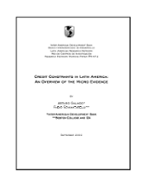Credit Constraints in Latin America: An Overview of the Micro Evidence
Date
Sep 2002
This paper summarizes and discusses new evidence on the nature, extent, evolution and consequences of financing constraints in Latin America; this evidence is drawn from a recent series of papers. The countries covered are Argentina, Colombia, Costa Rica, Ecuador, Mexico, and Uruguay. All the new contributions share the characteristics of being based on micro data. Most of the data sources are firms balance sheets. For Argentina information on debt contracts and credit history is also available, while for Costa Rica personal information on entrepreneurs was also collected. Some of the papers investigate the determinants of firms financing choices, and the consequences of access or debt composition on performance. Other papers attempt to assess the severity of financing constraints, by focusing on firms investment choices. All the papers (but one) were part of the project Determinants and Consequences of Financial Constraints Facing Firms in Latin America and the Caribbean, financed by the IADB. However, other recent micro-econometric contributions are discussed as well. The results suggest that access to credit (and its cost) depends not only upon favorable balance sheet characteristics, but also upon the closeness of the relationship between firms and banks as well as credit history. Access to long-term loans and to loans denominated in foreign currency is positively related to the size and tangibility of firms assets and negatively related to measures of country risk. Moreover, firms that have foreign participation appear to be less financially constrained in their investment decisions. The same is true for firms that are associated with business groups. On the whole, it appears that financial liberalization tends to relax financial constraints for firms that were previously constrained, while financial crises tighten them. However, firms that have more access to external sources of finance via, for instance, exports or ownership links, appear to suffer less in the post-crisis period. The paper concludes with a discussion of the policy implications of these results.



